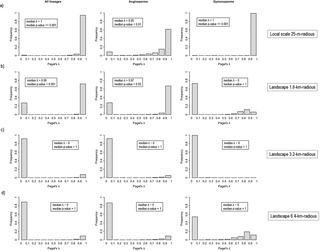PLOS ONE ( IF 2.9 ) Pub Date : 2018-09-20 , DOI: 10.1371/journal.pone.0204365 Rafael Molina-Venegas , Sonia Llorente-Culebras , Paloma Ruiz-Benito , Miguel A. Rodríguez

|
Evolutionary history can explain species resemblance to a large extent. Thus, if closely related species share combinations of traits that modulate their response to environmental changes, then phylogeny could predict species sensitivity to novel stressors such as increased levels of deforestation. To test this hypothesis, we used 66,949 plots (25-m-radius) of the Spanish National Forest Inventory and modelled the relationships between local (plot-level) stem density of 61 Holarctic tree species and forest canopy cover measured at local and landscape scales (concentric circles centred on the plots with radiuses of 1.6, 3.2 and 6.4 km, respectively). Then, we used the output model equations to estimate the probability of occurrence of the species as a function of forest canopy cover (i.e. response to forest loss), and quantified the phylogenetic signal in their responses using a molecular phylogeny. Most species showed a lower probability of occurrence when forest canopy cover in the plots (local scale) was low. However, the probability of occurrence of many species increased when forest canopy cover decreased across landscape scales. We detected a strong phylogenetic signal in species response to forest loss at local and small landscape (1.6 km) scales. However, phylogenetic signal was weak and non-significant at intermediate (3.2 km) and large (6.4 km) landscape scales. Our results suggest that phylogenetic information could be used to prioritize forested areas for conservation, since evolutionary history may largely determine species response to forest loss. As such, phylogenetically diverse forests might ensure contrasted responses to deforestation, and thus less abrupt reductions in the abundances of the constituent species.
中文翻译:

进化史预测树木物种对森林流失的反应:西班牙半岛的一个案例研究
进化史可以在很大程度上解释物种的相似性。因此,如果密切相关的物种共享调节其对环境变化响应的性状组合,那么系统发育就可以预测物种对新型应激源(例如增加的森林砍伐)的敏感性。为了检验该假设,我们使用了西班牙国家森林清单的66,949个样地(半径25米),并模拟了在当地和景观尺度下测量的61种Holcctic树种的局部(样地)茎密度与森林冠层覆盖之间的关系。 (同心圆分别位于半径分别为1.6、3.2和6.4 km的地块上)。然后,我们使用输出模型方程式来估计物种发生的概率与森林冠层覆盖度(即对森林损失的响应)的函数,并使用分子系统学方法量化了其反应中的系统发育信号。当样地的森林冠层覆盖率较低时,大多数物种显示出较低的发生率(局部尺度)。但是,当森林冠层覆盖度在整个景观尺度上减小时,许多物种发生的可能性就会增加。我们在当地和小景观(1.6公里)范围内对森林流失的物种响应中检测到了强烈的系统发生信号。然而,在中等(3.2 km)和大(6.4 km)景观尺度上,系统发生信号微弱而无意义。我们的研究结果表明,系统进化信息可用于对森林保护区进行优先排序,因为进化史可能在很大程度上决定了物种对森林流失的反应。因此,在系统发育上多样化的森林可能会确保对森林砍伐的反应截然相反,











































 京公网安备 11010802027423号
京公网安备 11010802027423号